From
the Desert -- A Breeding Evolution
The Desert Type
Arabian
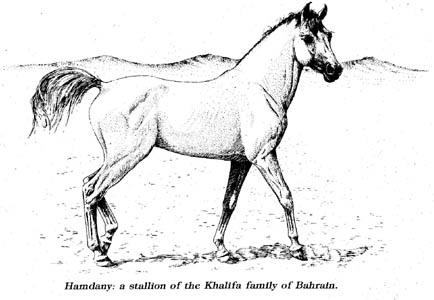
The horses found among the
nomadic Bedouin possessed certain common physical traits regardless of
their particular strain or family. Those who survived to maturity
all had the unmistakable look of an enduring athlete and warrior. In
the physical sense, "Desert Type" can best be described by the following
general traits:
1. Heads that have more distance from
the eye to the top of the skull than from eye to eyeacross the face.
2. The top of the
skull is in line with the eye and nostril, not bending backwards above the
eyes.
3. The bones of the lower jaw taper from
jawl to incisor.
4. Eyes that fill their sockets.
5. Extremely "dry" heads in old
age.
6. Unobstructed breathing represented by a
well defined trachea/esophagus leading to widely spaced jawls.
7.
A definite break in the outline between the neck and
withers.
8. Withers
slightly higher than croup.
9. Relatively short,strong backs.
10. The base of the dock of the tail is set
from the point of the buttocks.
11. The deepest point of the body is between the
forelegs.
12. A
noticeable girth groove.
13. The ratio of trunk and foundation strength to height at
the withers is a lower number in Desert Breds than in other Arabians.
14.
Exceptionally well shaped hooves and sound legs.
15. Thin skin and a noticeable bloom to
the coat.
16. An
overall appearance of a finely tuned athlete.
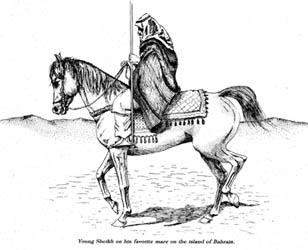
Back to top
Strains of Desert Bred
Arabians
Strains or families
are frequently used terms for grouping certain horses according to their
various Bedouin breeders. In the desert when individual horses
distinguished themselves in battle or performed exceptional feats of
speed, courage or endurance, strains or families were developed from
them. Certain tribes would focus on their influence, line breeding
and inbreeding to them producing special characteristics unique to their
family which was given a strain name, such as Kuhaylan, Abayyan, Hamdani,
Dahman, etc. The strain name was handed down from the tail female
line according to Bedouin custom as they rode only mares in warfare. Great
sires were prized for the strain or tail female line that they
represented. Although strain names are passed on through the tail female
line, care must be given to place certain emphasis on the entire pedigree
(all the strains represented) as well as that of the tail female line in
order to
correctly perceive an individual or plan a breeding.
Back
to top
The
Kuhaylan

In general the Kuhaylan strain is
characterized by a more masculine, balanced and symmetrical
appearance. They are broad across the chest, back, croup, forearm
and gaskin. The forehead is usually flat, if any bulge (jibah)
appears it is usually above the eyes. The head is usually wide and
short with small, alert ears. The Kuhaylan tend to be of a quieter
nature. They have a more forward type of movement which creates a
look of flowing lines from head to tail. While the Kuhaylan Ajuz and
Kuhaylan Haifi are very similar the more rare Kuhaylan Krush tend to have
a more sinuous appearance.
The Kuhaylan strain is represented by three branches: The Kuhaylan
Ajuz descending from the Sa’ud mare, *Turfa, The Kuhaylan Haifi
descending from the Davenport mare, *Reshan and the Kuhaylan Krush
descending from the Davenport mare, *Werdi.
Back
to top
The
Hamdani
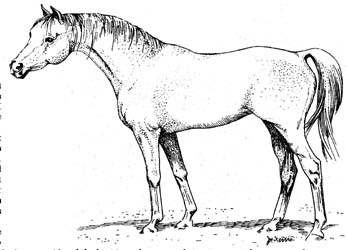
The Hamdani are considered
historically as being Kuhaylan related. Like the Kuhaylan they are more
masculine but of a slightly longer frame with a very strong back and more
prominent withers coming well out of the back. They are slightly
taller having strong bone of quality and substance with large
joints. The head of the Hamdani is clean and wedge shaped without a
lot of detail or prominence of tear bone and is slightly longer than the
Kuhaylan. The hind quarter is somewhat egg-shaped creating the
picture of power and speed. The Hamdani are considered the best in
endurance and stamina yet with very quiet dispositions. They are most
often bay or grey with very little white and they are a favorite strain of
the Sa’ud family. The Hamdani strain is incorporated in to our
breeding program primarily from the imported Sa’ud pure in the strain
Hamdaniyah mares, *Sindidah, *Rudann, *Halwaaji and her daughter, *Amiraa.
Also representing the Hamdaniyah strain in our program is the imported Sa’ud
mare, *Al Hamdaniyah, and the imported stallion, *Furtha Dhellal,a Hamdani
of the Dawasir.
Back
to top
The
Abayyan
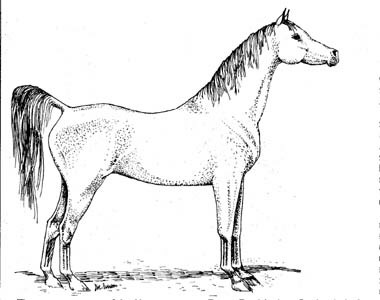
The Abayyan are
more refined than the Kuhaylan and Hamdani and slightly smaller.
They are noted for extreme tall carriage and a more lofty type of
movement. The head is characterized by a bulging Jibah at the
forehead and a fine, tapered muzzle. The Abayyan are longer in the
back with a slight saddle-back appearance and high set of the tall. They
are very deep in the barrel and forehand with broad forearms and a
serpentine like appearance. The shoulders are very prominent with
long withers and very clean boned straight legs. The Abayyan are
more spirited than the Kuhaylan and Hamdani. They are usually
bay,grey or chestnut with white markings more common than in the
Hamdani.
Back
to top
The
Dahman
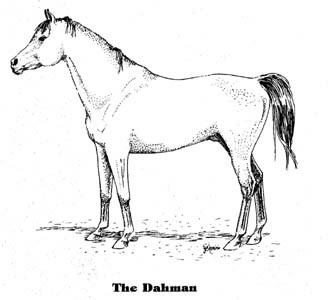
The Dahman strain
resembles somewhat the Abayyan and Saqlawi (related) strains in elegance
but with more of the strength of the Kuhaylan. It is an intermediate blend
of the Kuhaylan with the Saqlawi-Abayyan type. The head is short and broad
like the Kuhaylan but with more bulge and jibah. They are compact with
lines more like the Kuhaylan but with more over all refinement. They
are of medium build usually with dry, flatbone.
The Dahman strain is
presently represented by only one female line,
that of *Sawannah imported from Bahrain in 1954. The line is carried on
through her daughter, *Hadriya by the previously mentioned, *Jalam Al
Ubayan. This line descends from a Dahmah mare of Sheikh Sulman bin
Hamid al Khalifa, ruler of Bahrain. The Al Khalifa family has
occupied the island country of Bahrain since 1783 and they were originally
from a branch of the Anazah confederation.
Strain breeding is an
art, as well as encompassing the science of equine
reproduction. Any blend of several strain types may be
suitable for various horses under certain conditions. A study of the
various original Bedouin strain types is useful for both preserving these
types in their own form or for breeding blends for specific preferences.
Back
to top
From the Desert -- A
Breeding Evolution
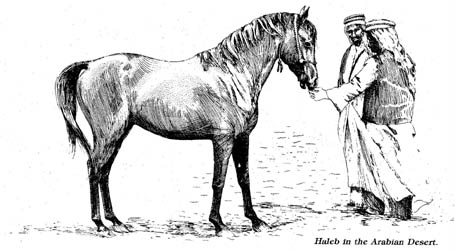
The Bedouin and the Desert
over many centuries, produced this selectively bred, prepotent horse
unique in its ability to endure and to pass on its desired traits.
This fact led to the exportation of the Desert Bred Arabian Horse from his
native land to many other horse breeding nations the world over.
Besides the continuance of the Arabian breed itself, certain choice
individuals were crossbred to improve other stock and therefore the Desert
Bred emerged as a dominant and desirable source of hot blooded
characteristics. All Thoroughbreds, in fact, trace to three such
Arabian stallions and most of this breed's early matrons contained liberal
amounts of hot blood. The Orloff Trotter of Russia, the Percheron of
France and the European Arabian all have the Desert Bred Arabian as a
common denominator. The Pashasof Egypt, the Blunts from England,
Polish and Russian, Hungarian and Spanish nobility as well as many early
breeders in North and South America owe the prepotent stallions of the
desert for the very foundation of their various breeding
programs.
Today, these
countries and areas contain large breeding herds of Arabian Horses.
Their global popularity has resulted in mixed breeding which has produced
Arabian Horses far more varied than their original desert ancestors.
This variation can be termed by some an improvement in some specialized
areas such as in the show ring and in flat racing where taller, bigger
boned, longer, faster and higher
stepping Arabians are in demand. The
consequence of this variation in type is that it does not allow those
breeders the genetic ability to regain the many desired traits of the
original Desert Bred Arabian Horse.
Back
to top


![]()